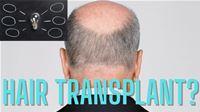The one question that keeps prospective patients up at night is whether they will get 'too bald' to have a hair transplant procedure. Hair transplant surgery is the only treatment that can grow hair on a completely bald scalp. However, you require an ample donor supply to harvest the hair to transplant to the balding areas. If you think you may be too bald for surgical hair restoration, keep reading.
Supply and Demand
We've all heard the phrase supply and demand. Generally, it's used to talk about commodities like oil or coffee, or even real estate. But supply and demand is everything when it comes to hair transplantation. I like to use the analogy of building a house. To build a house, you need four walls and a roof. Now imagine that the size of the house you need to build keeps getting bigger and bigger, but you don't have enough material. That's the situation you can find yourself in if you don't plan accordingly.
You may notice some recession at the temples or some minor thinning in the crown in the beginning stages of hair loss. But as time goes on, the temples will recede further, and the crown will expand until pretty soon the entire top of the scalp is bald. There are different severity levels of hair loss. For example, you can be a Norwood 5a completely bald on top, but your sides and crown are high up.
Norwood 5A
Norwood 7
Conversely, you can have the most severe hair loss level and be classified as a Norwood 7. If you're a Norwood 7, your sides have dropped, your crown has expanded from the top to the middle of the backside of your scalp. In most cases, Norwood 7 also suffers from retrograde alopecia, a condition that causes the nape to recede upward. All of these issues can make getting a hair transplant challenging, to say the least. That said, being a Norwood 7 doesn't automatically remove you from candidacy. It all depends on the quality of your hair and the quantity of your donor supply. Not all surgeons are equipped to tackle such a difficult case, so finding the right hair transplant surgeon is vital.
Diffuse Unpatterned Alopecia (DUPA) and Alopecia Areata
Some conditions prevent you from being a suitable candidate for surgical hair restoration. The most common condition is called DUPA. DUPA is similar to genetic hair loss, except the entire scalp is affected by DHT, as opposed to only the top in traditional male and female pattern hair loss. Unfortunately, you're not a candidate if you have DUPA because the hair on the top of your scalp isn't stable and could thin over time.
Alopecia Areata is an auto-immune condition that attacks the hair follicles. The hair loss is usually patchy, with small balding areas the size of a quarter appearing all over the scalp. Because this condition is caused by your immune system attacking your hair follicles, receiving a hair transplant isn't suitable. Instead, this condition can be treated with steroid injections, and in most cases, resolves on its own.
Conclusion
Can you be too bald? Yes and no. It boils down to your expectations. If you're a Norwood 7 and you want to regain the head of hair you had when you were a teenager, then yes, you're too bald for surgery. However, if you're a Norwood 7 with reasonable expectations, and your goal is to get some hair back- then no, you're not too bald for surgery. The only way to know for certain is to submit your photos to several world-renowned hair restoration physicians. That is the best way to know if you're a suitable candidate. To submit free consultations to one of the recommended surgeons on this site, click HERE. Our surgeons' directory is approved and backed by actual hair transplant reviews and results, not marketing and gimmicks.

